|
Welcome
Legacy & Stewardship
Our Puppies
Our Sires & Dams
Education: Books, Videos & Herding Clinics
What new at Las
Rocosa?
History
Las Rocosa Gallery
All About
Aussies Blog
Site Directory
Contact Us |
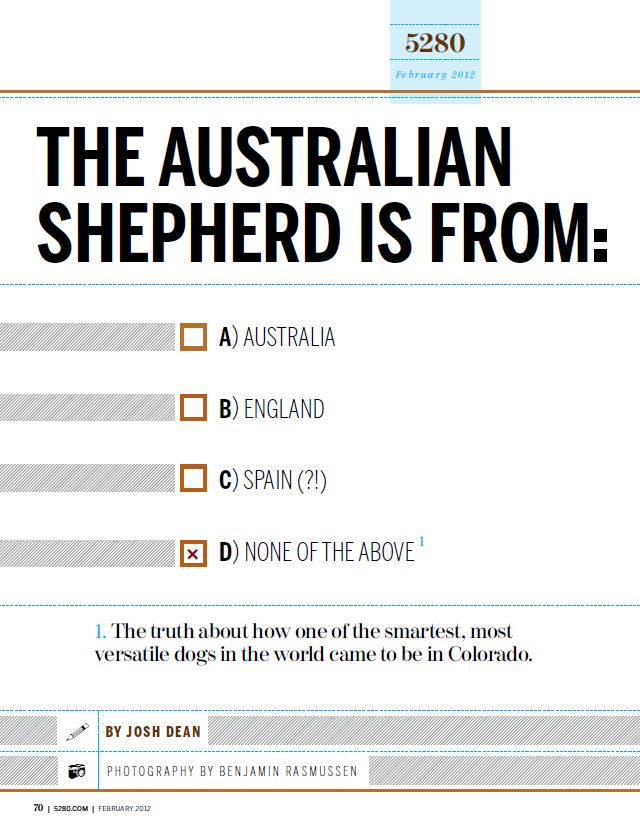
|
When Ernie Hartnagle came home from World War II in
1946, having served two and a half years in the Seventh Pacific Fleet and participated in
the liberation of the Philippines, there was no time to
relax or recuperate or bask in the plaudits of his
nation. Though just 20 years old, he was, like many
other young veterans, seasoned by his experiences. And
that was a good thing, because his father died while
Ernie was away in the Navy, and being the oldest child,
it fell upon him to assume the mantle of the Hartnagle
family upon his return.
That responsibility included running the family’s
99-acre ranch in Boulder, purchased by Ernie’s parents
in 1929, the year of the stock market crash, and held on
to with hard work and gritted teeth through some lean
and difficult times, and providing for his mother, two
brothers, and a sister. He quickly found that the
ranch’s yield alone wasn’t enough and began to travel
each spring to his Uncle Frank’s Bar-K Ranch in the Gore
Range, on land that is today Vail Ski Resort.
|
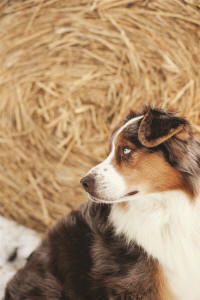
OL’ BLUE EYES, Foddy, a male red merle
Australian Shepherds,
on the Hartnagle Ranch
|
|
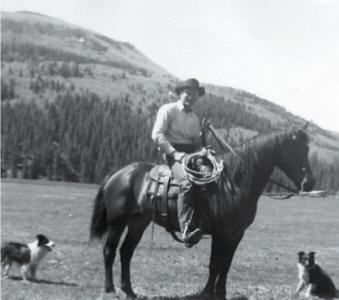
More than 50 years ago, Ernie and his
dogs
shepherded cattle in the Vail Valley.
|
There, he and Frank would fatten the herd of cattle by
driving them from one mountain meadow to another,
chasing the lush, seasonal grasses of the Rocky
Mountains. Once summer began to set in, the herd would
be based in the high country, at 11,500 feet, but for a
period in early May, some of the best grass was found in
the pastures in the valley at 8,100 feet. So every
morning before dawn, Frank and Ernie would round up the
cattle with the help of their stock dogs and drive them
3,400 vertical feet down the hill for a few hours of
grazing.
But temperatures rise quickly at that time of year, and
if the men and dogs couldn’t get the cows moving back up
the steep slopes, which are now blue and black diamond
ski runs, to the cooler fields atop the mountains, the
cows would grow obstinate and ultimately so troublesome
that even the dogs would wither. All of the dogs, that
is, except for one.
A couple of Uncle Frank’s dogs were border collies
imported from Nottingham, England. The border collie is
the world’s unrivalled champion of sheep herding, a breed
honed for this specific purpose over hundreds, and
perhaps thousands, of years. But border collies were
then newer to working with cattle and were certainly not
accustomed to covering thousands of feet of elevation
gain, at high altitudes and in wildly divergent
temperatures, over the course of a single work day. |
When the day grew too hot, and the climbs too taxing,1
these collies, famous for their drive and endurance, would fade and
quit just like the cows, while a single black, bobtailed dog named
Rover seemed inexhaustible. No matter the temperature, or the
elevation, Rover would race uphill and downhill, nipping and barking
at the cows until they resumed their march. The only way to get him
to stop working was to force him to do so, and Ernie believed that,
if not for human intervention, Rover might work himself to death.
Rover was the finest dog Ernie Hartnagle had ever seen, and he
resolved to get himself a bobtail or two for his own ranch, once he
had the money and could locate the source. At the time, he had no
idea where to get one,2
or how far this special kind of dog, which he’d gotten to know on
the slopes of the high Rockies, would take him.
|
At least in the national consciousness, Colorado is a
state with two reputations. There is its historic,
pioneering side, which conjures visions of wide-open
space and libertarian freedoms and cowboys on horseback
ranching sheep and cattle. And there is its modern-day
connotation, of ski slopes and national parks and
progressive idealism, where healthy, attractive men and
women in microfiber garments jog and bike trails and
appreciate the state’s natural beauty in more
recreational fashion. And there, connecting these two
worlds, is the Australian shepherd.
The Aussie, America’s 26th most popular breed, isn’t
Colorado’s official state dog, but it really should be.3
Considered a midsize dog of prodigious energy and high
intelligence, its general appearance, according to the
official American Kennel Club (AKC) breed standard, “is
well-balanced, slightly longer than tall, of medium size
and bone, with coloring that offers variety and
individuality.” Unlike the standards for many of the
fussier breeds, which focus largely on physical
characteristics, the Aussie’s official definition is as
much about its personality and agility: “He is
attentive and animated, lithe and agile, solid and
muscular without cloddiness.”
“The Aussie was selected specifically as a generalist,”4
says Carol Ann Hartnagle, Ernie’s youngest daughter, and
she would know. No family has held more sway over this
breed than the Hartnagles of Colorado. The primary
reason the Australian shepherd has become both the
world’s best herding and adventure dog—as well as an
excellent companion and a capable guardian—is that the
Hartnagle family, and the handful of others who helped
shape the breed over the past 75 or so years, embraced
its intelligence, drive, and adaptability to create a
dog that can and will do just about anything. “The
Australian shepherd’s hallmark is its versatility,”
Carol Ann, who’s 48, explains. “These dogs just have a
high desire to please.”
It’s hard to imagine now, but for nearly 70 years the
Hartnagles owned and grazed flocks of sheep inside
Boulder’s current city limits. A blue heron rookery was
just east of the ranch, and both Boulder and Dry creeks
passed through the property. It was in large part on
this land, which was also home to a 53-acre reservoir
(known today as Hartnagle Lake), that the little blue
bobtailed sheepdogs of the American West -- defined, in
look and character, by Rover, and others like him—became
the breed we now know as the Australian shepherd.
There were dogs that looked and acted very much like
today’s Aussies a long time before Rover, and certainly
before the dogs bred by the Hartnagles. But you won’t
find much unanimity in the Aussie community over the
breed’s precise origins before the 1940s, at least in
the distant sense. Everyone agrees that the dogs are
not actually, despite their name, a product of
Australia, but beyond that there’s little agreement.
What is likely is that the breed as we know it arose
semi-organically on sheep ranches in the middle and far
West of the United States over a period of many years
starting in the mid-1800s.
The best guess of what happened with the Aussie is that
a variety of shepherd dogs were working in the western
United States -- Colorado, Wyoming, Idaho, and
California in particular -- interbreeding with whatever
other herding dogs happened to be working nearby. The
gene pool further diversified when dogs from Europe
began to arrive in the late-19th century, along with
reinforcement flocks meant to replace sheep that had
originally arrived with the Spanish conquistadors, but
which became lunch during the California gold rush and
Civil War. These dogs accompanied sheep that may have
been imported from Australia -- which is one good guess
as to how the name arose. Other shepherd dogs that
existed in the West originated specifically in Spain --
these were larger dogs -- and so the argument can be
made that Australian shepherds are largely Spanish, and
specifically Basque.5
The reality is that it’s impossible to reconstruct an
exact history of the Aussie. It’s not uncommon for dog
breeds to lack a succinct, annotated history. Although
many were very specifically engineered from a traceable
set of forebears,6
others -- like the Aussie -- just sort of happened by
circumstance. The Australian shepherd isn’t Australian,
or English, or Spanish. It’s all of the above. Though
the best answer of all is that it’s American, with the
West, and Colorado in particular, at its core.
By the mid-20th century,
around the time Ernie was first smitten by Rover, it had
finally occurred to people to start writing things down,
and the story of the Australian shepherd began to
crystallize. Before that, dogs that appeared to be
Aussies were doing their jobs all over the West, but no
one seemed interested in documenting their provenance.
It didn’t matter to most owners where a particular dog
came from, or who its sire was; it only mattered that
the dog was good at its job. Very often you will find
these dogs referred to in old texts as “little blue
dogs” or “little blue bobtails” or, especially among
natives in Colorado, “ghost-eye dogs,” and it’s pretty
clear that the three common physical characteristics of
the Australian shepherd, as it developed organically,
were a blue coat, a bobbed tail, and a high occurrence
of blue eyes. |
DOG DAYS:
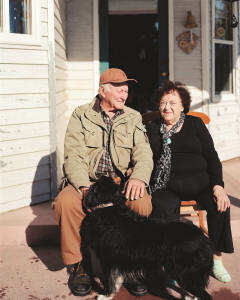
Ernie and Elaine
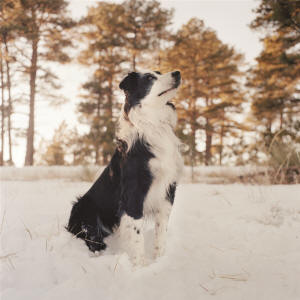
Francis, a male Aussie, on the ranch
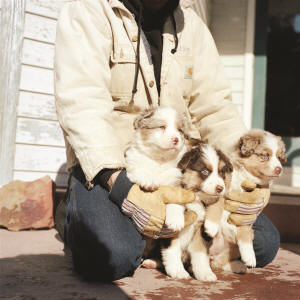
Three Aussie pups |
|
FAMILY TRADITION:
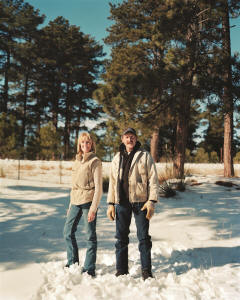
Carol Ann and Jimmy
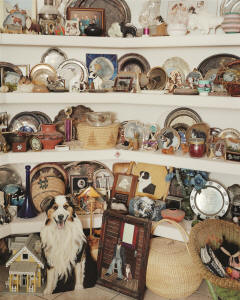
Hartnagle family award and
memorabilia
collection

Ernie’s Dorset sheep
|
The characteristic that led to these dogs becoming a
formal breed, however, was the thing that struck Ernie:
their ability to “work” livestock -- at first sheep, but
also horses, cows, ducks, geese, or any other animal a
farmer might need to tend to.7 And because of
their remarkable abilities, bobtails began to show up in
and around Colorado.
Rover was the dog that first caught Ernie Hartnagle’s
eye, but it was a pair of dogs he encountered at a local
stock show in 1952 that forever changed the course of
his family’s history. There, Ernie met Jay Sisler, a
rodeo star whose act starred Stub and Shorty, a pair of
blue bobtails who performed dozens of remarkable tricks
and became so beloved and famous while part of a touring
show that they went on to star alongside Slim Pickens in
a 1956 Disney television show titled Cow Dog.
Ernie couldn’t believe what he’d just witnessed at the
show -- dogs walking for minutes on end on hind legs, or
doing handstands atop broomsticks, and any number of
other impressive, intricate tricks on command -- and
after the performance he sought out Sisler, who told him
that these off-the-chart smart dogs, which looked and
acted like Rover and the other bobtails he’d seen
working sheep, were known as Australian shepherds.
“We’d never heard that name before,” Ernie recalls,
“but we decided then we’d get some of those dogs.”
One year later, in 1953, Ernie met and fell in love with an A&W Root
Beer stand carhop named Elaine Gibson, who just happened to have
grown up amongst these dogs herself. Elaine knew them as “bobtailed
shepherds,” and the Gibsons of Wyoming had owned them as far back as
the 1920s, when her grandfather had one he called Bob (for its tail)
that he used to bring his colts in from the range to prevent them
from being attacked by mountain lions. It’s a funny coincidence,
Carol Ann says, “that both of my parents have a very unique history
in parallel with these dogs.”
The Hartnagles acquired their first bobtail together the same year
they met, a female named Snipper, and very quickly sought to add a
second dog like her to the family. In 1955, when Ernie spotted an
ad in the Denver Post for “blue Australian shepherds” at an address
outside Littleton, he drove down and met Juanita Ely, a “salty ranch
woman from Idaho,” as Ernie describes her. Ely got her blue dogs
from Basque shepherds, and the animals looked a lot like Rover and
Snipper. Ernie and Elaine were thrilled; they’d found their source.
The Hartnagles took home their second Aussie, Badger, and were so
taken with his herding ability and courageousness that they went
back to Ely again for Goodie, Badger’s half-sister. Those two dogs
became the foundation of the breeding program for all the family
dogs that would follow.
It was Ely, Ernie says, who is probably most responsible for the
Aussie getting its start. Though Ely’s goal was never to open the
pipeline, by breeding high-quality blue, bobtailed sheepdogs of
Basque origin, Ernie says, “She was the fountainhead.”
Back home in Boulder,
Ernie and Elaine began to mate one good bobtail to another with the
sole criterion in selection being the dog’s aptitude to work, and
the Australian shepherd as we know it today began to take shape.
The idea, at the time, wasn’t to build a kennel. “We just liked
the dogs. And we liked what we had,” Ernie says. “But I got to
thinking, ‘Boy, everybody with livestock should have one of these
dogs.’”
The Hartnagles started by breeding dogs for themselves
in 1955, but word of the Hartnagles’ dogs soon spread
across Colorado, and then across the entire western
United States: If you needed a good cow or sheep dog,
you went to Boulder to see the Hartnagles. Las Rocosa8
Kennel was christened in 1970, and by then the
Hartnagles were averaging about eight litters a year.
Today there are four recognized colors for purebred
Aussies: the blue merle, the red merle, the red tri, and
the black tri, and among the landmark accomplishments to
originate at Las Rocosa was the introduction of the red-colored
Aussie (in 1970) and the recognition that black dogs, in
addition to reds, were just as capable as the legendary
blues. “We lifted the black dog out of the cheap
seats,” Ernie says. “We said we believed that color
doesn’t make any difference. You may like one better,
but the black dogs are just as good as the blue dogs.”
To make that statement as clearly as possible, the
Hartnagles set a single price for their puppies,
regardless of color. This wasn’t just unprecedented; it
was revolutionary. Years ago, before the Hartnagles
vouched for the quality of red and black Aussies,
ranchers often killed the puppies to save themselves
from having to raise a dog that couldn’t work. As Ernie
explains it now: “People did not understand breeding
these dogs.”
|
|
Very quickly, red came into vogue, and the Hartnagles figured out
that, because the color was a recessive trait, the only way to
produce red out of non-red dogs was if both parents had the gene in
their backgrounds. Today, breeders can learn the genetic makeup of
their dogs through simple DNA tests, but back then, Ernie says, “It
was just a step-by-step process. The only way you learned something
is you made a mistake.” And when you did, “you made a rule so you
wouldn’t make that mistake again.”
The Hartnagles weren’t alone. Colorado became the hub of Aussie
activity, mostly because it was a center for American livestock.
(The National Western Stock Show was an unofficial gathering for
Aussie breeders and enthusiasts.) Las Rocosa -- which, in 1991,
would become the first kennel awarded Hall of Fame status by the
Australian Shepherd Club of America and later became the first to be
given Hall of Fame Excellence status -- provided many of the
foundation dogs you’ll find in the Aussies of today.9
The Hartnagles weren’t the only ones pursuing the perfect Aussie.
Ernie says that pretty much every Aussie in America has its origins
in five basic foundation lines, and all but one of those lines comes
from a Colorado breeder. First and foremost, obviously, is Las
Rocosa, with the other key players being Juanita Ely, Fletcher Wood,
and Dr. Weldon Heard. Whereas Ernie Hartnagle was in pursuit of the
ideal herding dog, Heard, through his Flintridge kennel, was chasing
a different sort of perfection and was focused more on structure and
appearance, which translated well into the conformation ring.10
Specifically, Heard studied and followed the strategy of old German
Weimaraner breeders, who would allow only the top two puppies from
each litter to reproduce.
Heard’s impact on aesthetics was especially huge. “Of all the
foundation bloodlines,” the Hartnagles write in The Total Australian
Shepherd, “the Flintridge line exhibited the greatest influence on
the modern show Australian shepherd.” Heard died in 2008, and by
that time had stopped breeding dogs. Likewise, the lines of Juanita
Ely, Fletcher Wood, and Jay Sisler have also long since ceased. Of
the five foundation lines of the Australian shepherd, only Las
Rocosa is still active, through the work of Ernie’s two
Colorado-based children, Carol Ann and Jimmy.
|
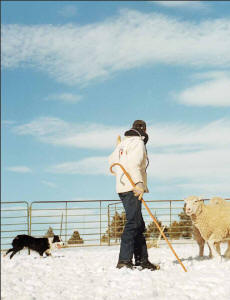
Jimmy in the dog training pen
on the
ranch |
|
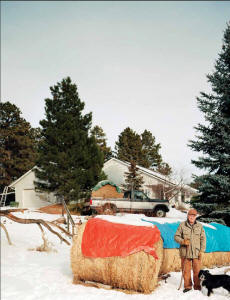
Ernie with Brombie near the
ranch house |
By the 1990s, the city
of Boulder had grown so rapidly that it basically encircled the
Hartnagle family ranch. In 1997, Ernie and his family sold it to
the city, and it became “open space.” Now, pretty much every day of
the year Boulder residents jog and hike on this land, often with
Australian shepherds at their sides. Bisected by Boulder Creek, and
with sweeping views of the Flatirons, it is some of the most
pristine land remaining in the city.
Ernie and Elaine relocated to a smaller, 78-acre ranch
near the town of Kiowa, about an hour southeast of
Denver, where, in addition to a couple of horses and a
donkey named Lila Jane, the couple keeps a pair of
Aussies that assist Ernie in his daily chores. Among
their jobs: fending off coyotes, rounding up Ernie’s
flock of purebred Dorset sheep11, and separating specific
animals when it comes time for vaccinations. Ernie,
tall, broad, and ruggedly handsome, even in the second
half of his 80’s, still shears the wool and on occasion
ventures out to judge some of the Australian shepherd
herding competitions.
Carol Ann (and her husband, Kenneth Madsen) and Jimmy
(and his wife, Lisa) are now the primary torchbearers
for the Las Rocosa brand. Carol Ann and Kenneth own
nine Australian shepherds ranging in age from three to
15, and the couple still breeds, but no more than one
litter a year from their small Adams County farm. She
says she can’t remember any part of her life that didn’t
prominently feature Aussies. The dogs worked with her
siblings in the pastures, and the family traveled to
herding competitions12
on weekends. “I’ve known nothing else than having these
dogs as part of our lives as companions and guardians
and partners on the ranch,” she told me. |
By the time Carol Ann was born, in 1963, Las Rocosa was so abuzz
with Aussies that “the dogs almost raised me,” she says, and she’s
only exaggerating slightly. One of her earliest memories on the
farm, she recalls, is of a dog named Daisy who was entrusted with
the very important task of keeping the toddlers away from the long
driveway that led to the busy road out front. Daisy was taught to
give the kids a certain amount of leeway, but if they reached a
certain point, “she would interrupt us and dissuade our path,” Carol
Ann says. “She would gently take our hands in her mouth. Her task
was to keep us safe. It was amazing.”
Carol Ann says one of the things she’s most proud of is that --
despite the fact that official AKC recognition in 1983 caused a
spike in popularity that continues to this day, and the fact that
the dogs have found a second niche as the go-to breed for the
hiking/biking/skiing adventurer -- the Australian shepherd is still
primarily doing what it was bred for. “A significant number are
still raised for real-world conditions,” she says, meaning for
working on ranches, with sheep and cows. “Not too many breeds in
America that can claim that.”13
|
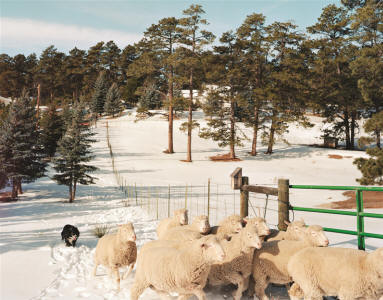
Working for a living - One of the
Hartnagles’ Australian Shepherds, Brombie,
moves Dorset
sheep to the ranch’s dog-training pen. |
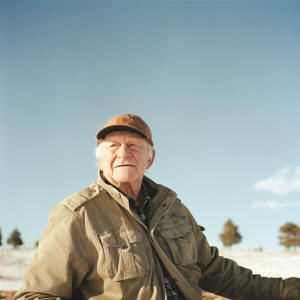
AMERICAN ORIGINAL:
Ernie Hartnagle on his ranch in Kiowa. |
Though she has a busy career as an executive for a professional
records management company, Carol Ann, like her sister Jeanne Joy,
the author of All About Aussies: The
Australian Shepherd from A to Z, still travels widely --
even sometimes overseas -- to judge Australian shepherd conformation
and stock trials. One reason she breeds so few litters is that she
insists on being present for the births and for the early weeks when
the dogs’ personalities begin to develop.
The last time we spoke, in early December, she had a litter of
puppies that was just 14 days old. It was a breeding she’d been
planning for four years, and when the pups arrived, it was a
profound occasion. Both the sire and the dam have lineages that go
back to the very first dogs that Ernie and Elaine used to start the
Las Rocosa line. These puppies, Carol Ann said, “are the 16th
generation of our family program.”
Ernie might no longer have much of a hand in the operation, but Las
Rocosa’s impact lives on. “I would say definitely that the breed is
synonymous with our family,” Carol Ann says. “Anybody who has
knowledge of the breed would understand that, and conversely no one
can know anyone in our family without knowing the synergistic
connection to Australian shepherds. They’re one and the same.”
Footnotes:
1. In places,
the terrain was so steep that the men had to dismount their horses.
2. The idea
that a dog would have a specific, traceable, documented lineage was
an utterly foreign idea to Ernie, and probably most people, at the
time.
3. There are
currently just 11 U.S. states with an official state dog. The honor,
believe it or not, requires an act of the state Legislature.
4. This stands
in stark contrast to the majority of dog breeds, which were bred
with very specific purposes in mind. The dachshund was bred, for
instance, to crawl into holes and ferret out varmints, which is why
it’s so feisty and prone to tearing small objects to shreds.
Another popular ranch dog, the border collie, was refined by the
English and Scottish for hundreds of years to work with sheep. It’s
a champion of sheep herding, but it doesn’t want to do much else.
If you buy a border collie and ask it to be your house pet, prepare
for shredded carpets and herded children. That’s because, explains
Carol Ann, “a border collie’s desire to please a handler is not
greater than their desire to pursue their own instinct.”
5. In the
years after World War II, a federal government program, in
conjunction with the Western Range Association, granted three-year
visas to foreign shepherds who could help fill in for the lack of
able-bodied males in the United States. Many were Basque.
6. For
instance, the bullmastiff was created by English game wardens to
ward off poachers by mixing tenacious bulldogs with hulking
mastiffs.
7. Including
children. Aussies are famous among farmers for their ability to
pitch in with babysitting.
8. Spanish for
“the Rockies.”
9. “Foundation
dogs” is breeder jargon for the most prominent specific animals in a
pedigree. If you trace a modern Aussie’s family tree back far
enough, there’s a very good chance you’ll find some Hartnagle dogs
in there.
10. That’s a
fancy word for dog shows of the kind you see at Westminster in New
York City.
11. Numbering
38, Ernie’s flock is one of the largest in the region for this
breed.
12. These events
started, in large part, due to the efforts of Ernie and Elaine to
increase interest in the breed.
13. When was the
last time someone you knew bought a terrier, for instance, for the
primary purpose of killing rats?
Back to top of page
Josh Dean is
the author of Show Dog: The Charmed Life and Trying Times of a
Near-Perfect Purebred, which published by HarperCollins. His
writing has appeared in GQ, Outside, Men’s Journal, and the New York
Times. Email him at letters@5280.com.
|

HARTNAGLE’S LAS ROCOSA AUSSIES
E-mail:
lasrocosaaussies@aol.com
Telephone: 303.659.6597
Fax: 303.659.6552
Breeding Sound Versatile Aussies Since 1955
Founding/Lifetime Members ASCA and USASA
Copyright© 1999-2015. All
information, pictures & graphics contained on this website belong to
Las Rocosa Australian Shepherds & cannot be reproduced without
written consent. All Rights Reserved.
The Hartnagle's Las Rocosa
website designed & maintained by
Mikatura Web Design
|
|













